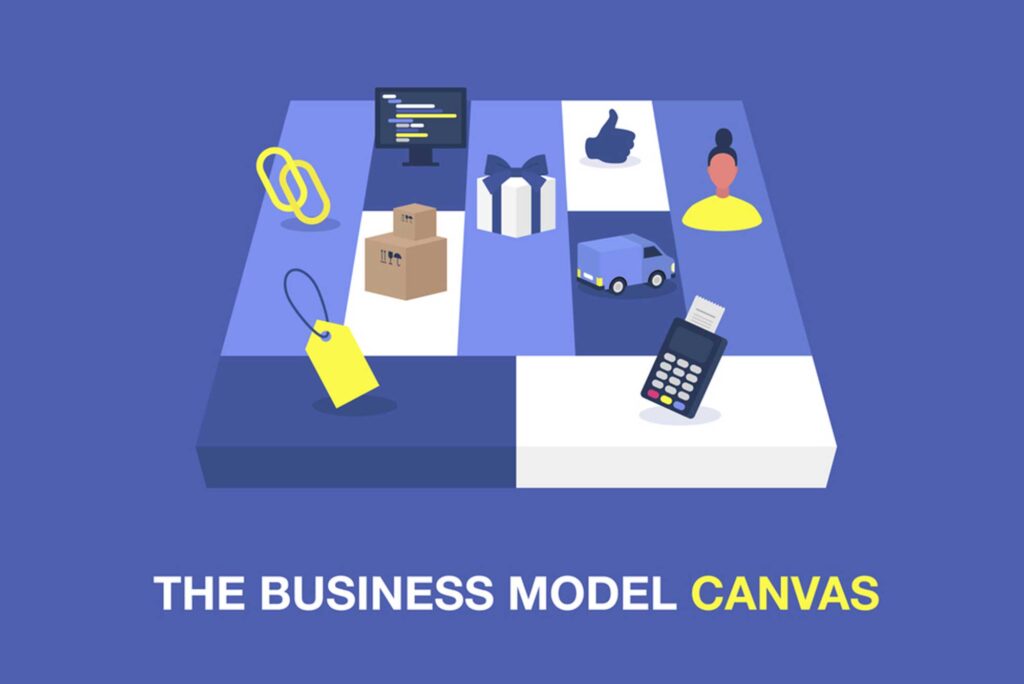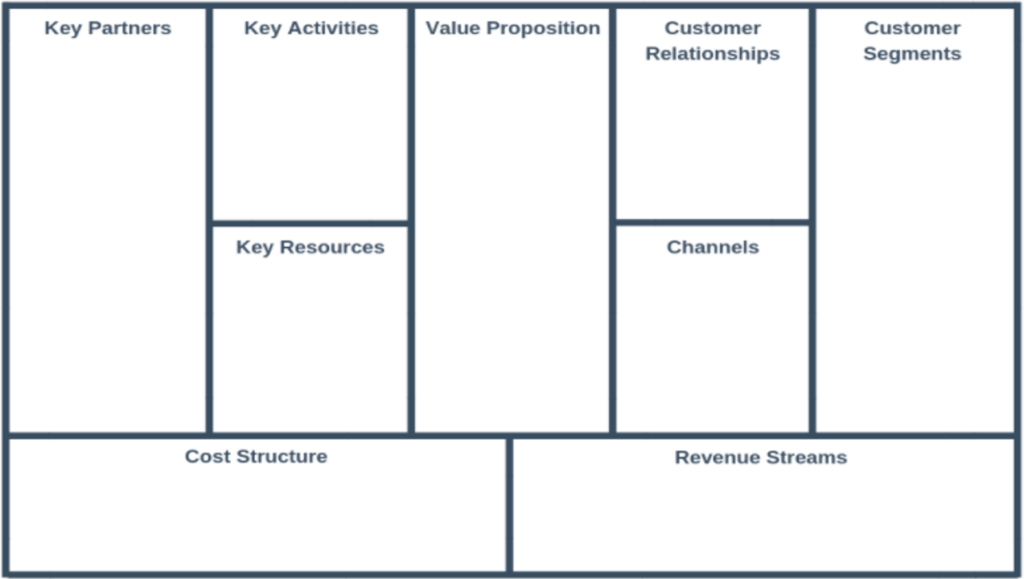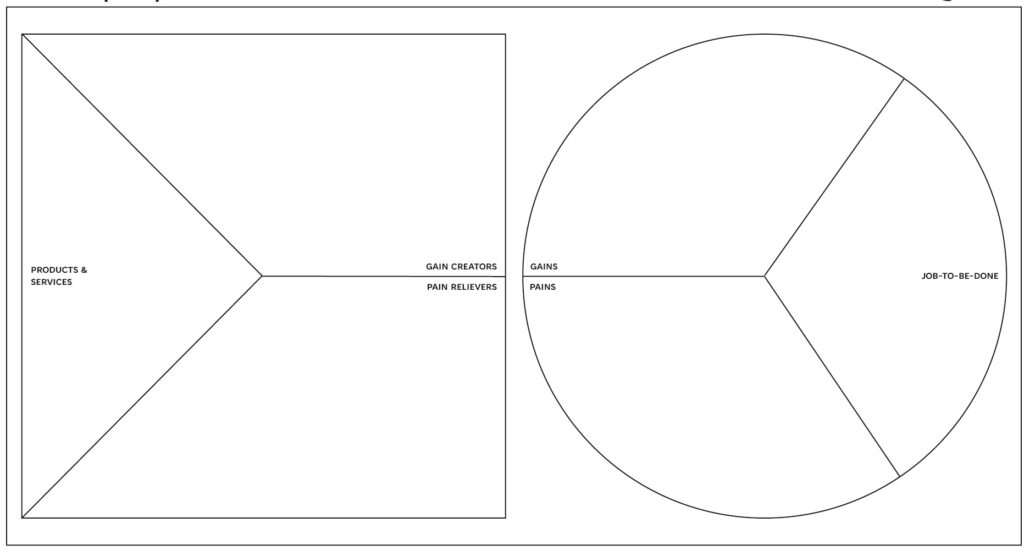
What is a Business Model Canvas?
A business model canvas is a visual tool that helps plan for a business. It has nine parts and can be used to model any business, big or small. The nine parts are as follows:
- customer segments
- value proposition
- channels
- customer relationships
- revenue streams
- key resources
- key activities
- key partners
- cost structure
An example of a business model canvas is seen below. You can complete the model as we explain each section, provide questions for you to answer, and give examples from famous companies.

At the end of each sections is the classroom example, in which our business rents out bicycles to ride primarily on campus for students.
1 customer segments
To complete the customer segments section you need to ask yourself which customers are you serving.
Your business is centered around your customers therefore it is important you know who they are and how you can help them.
It is common to identity the characteristics of your customers and group them. By defining these groups you can create personas, imaginary descriptions of your target customers.
- who are your customers?
- what segment of customers are you targeting?
- who are you meeting the needs?
- who’s problems do you solve?
- what customer segment do you offer value?
Examples:
- Facebook – Internet users, advertisers and marketers, developers
- Airbnb – guests (business & leisure), hosts, providers (tour companies), photographers, hotels
Classroom Example:
- students
- other users on campus
- city center users e.g. tourists
1 value proposition
The values proposition identifies the product or service that you are offering to each of the customers that you identified in the first section.
What exactly are your customers looking for in your products and services?
- what are your products or services?
- what features of these meet customer needs?
- what features will make customer choose your product or service over competitors?
- why will customers choose your product or service over competitors?
- what customer problems do you solve?
Examples:
- Facebook – connect with friends, social content, engagement, personalized experiences, social distribution, payments
- Netflix – 24/7 on demand entertainment, high-definition shows, streamed content, unlimited access, 30 day free trail, no commercials
Classroom Example:
- allow students to easily travel around campus
- convenient payment system

A value proposition canvas is a model that allows you to list the jobs and tasks that a customer does, what issues and pain points they suffer, and what gains might be experienced by the customer.
These observations can then be matched to your value propositions, your main products and services, the pain points that could be relieved, and the benefits and gain could be experienced by these.
3 channels
We know what to offer our customers but how do they want to be reached, through which communication channels?
For example do our customers want to locate and purchase through a physical channel like a store, or a digital channel like a website or phone app.
How do we find our customers and how do they find us? This includes paid ads for example.
- how will your product or service reach your customers?
- how will customers buy your product or pay for your services?
- what physical channel can your products or services to accessed (e.g. shop)?
- what digital channels can your products or services to accessed (e.g. web, phone)?
- how will you communicate with your customers?
Examples:
- Netflix – any device, Netflix app, word of mouth, online advertising, offline advertising, social media
- Airbnb – digital add campaigns, social media, app store, PR media coverage
Classroom Example:
- digital – phone app (includes locating bicycles)
- physical – convenient bicycle stations
4 customer relationships
By understanding our customers we will know how best to attract and look after them, thus having a good relationship with our customers.
This could be in the form of knowing one person a long time, or dealing with many people in a short time.
Nevertheless, physical or digital contact with your company should be a pleasant experience for a customer.
- How will you get customers?
- How will you keep customers?
- How will you grow customers?
- How will you make customers have a good experience of your business?
- How will you make customers prefer you over competitors?
- Why will customers recommend your products and services?
Examples:
- Netflix – self service, on-demand, ease of use
- Airbnb – self service, trust through verification, tailored, manage bad behavior and risks
Classroom Example:
- get customers – campaign / promotion
- keep customers – quality & reliability equals good reputation
- grow customers – easily transferable business model to other campuses
5 revenue streams
What are your customers really willing to pay for, and via what payment method?
Different services or customers may pay different prices, due to size, frequency, quality, loyalty or other reasons.
A different approach may also be profitable, such as the strategy to auction advertising with Google ads rather than just selling them.
Consider what revenue you expect, how much and how often.
- how will you make money?
- what revenues will your business provide?
- are their alternative revenues that your business could facilitate (e.g. advertising)?
Examples:
- Facebook – free,ad revenues, payment revenues
- Netflix – subscription model, product placement, DVD rentals, future model – licensing own content
- Airbnb – service fee per transaction, hosts commission charge, hotel commission charge, experience commission charge
- Tesla – car sales, servicing
Classroom Example:
- bicycle hire charge
- advertising e.g. on bicylces
6 key resources
To complete the section on key resources ask yourself what resources do you need to be able to offer the desired value to customers.
The assets necessary for the business include people, equipment, buildings, intellectual property, and other intangible assets. These assets are crucial for our business to function.
- what are the resources required by the value propositions and customer relationships?
Examples:
- Facebook – platform, technology infrastructure
- Netflix – brand, apps and website, platform, employees, awards
- Airbnb – platform, mobile app, patents, brand, employees
Examples:
- Netflix – investors, media producers, film maker guides, TV networks, Amazon AWS, regulators, consumer electronic companies, cinemas & theatres
- Airbnb – hosts, hotels, experience providers, corporate travel providers, investors, lobbyists, photographers, maps, AWS cloud hosting
7 key activities
To make the business function we need to be successful in performing key activities such as marketing, research or customer service for example.
These are the tasks that we must perform well to be able to provide to our customers the service described in the value proposition.
- what are the activities required by the value propositions and customer relationships?
Examples:
- Facebook – platform development, data center operations management
- Netflix – technology R&D, content licensing, production and distribution, data analytics, sales and marketing
Classroom Example:
- general business running activities
- keep customers happy (surveys/ interviews)
8 key partners
Although it may seem that you do everything in your business, there are other people that contribute to the running and hopefully success of the company.
This group can range from the knowledge and skills providers inside the company to the suppliers, partners and investors.
- which partners do you need?
- which stakeholders do you need (e.g. suppliers, investors)?
- which businesses and services are required to meet your needs?
Examples:
- Netflix – investors, media producers, film maker guides, TV networks, Amazon AWS, regulators, consumer electronic companies, cinemas & theatres
- Airbnb – hosts, hotels, experience providers, corporate travel providers, investors, lobbyists, photographers, maps, AWS cloud hosting
9 cost structure
What are the top expenses for your business?
Detail how much, how often, does it change, does it change relating to sales, seasonal etc. These are fixed and variable costs.
Costs include rent, wages, materials, bills, marketing, start up costs, running costs, etc.
- what are the most important costs relating to your key activities and resources?
Examples:
- Facebook – R & D, data center costs, marketing and sales
- Netflix – production, R & D, licensing, AWS infrastructure, marketing, payment processing fees, general / admin
- Airbnb – cost of acquisition, cost of capital, R & D, payment processing, payroll, legal, insurance, lobbying, PR, customer support
- Tesla – manufacturing & assembly plants, R & D
Classroom Example:
- fixed e.g. marketing, web app costs
- variable e.g. bicycle repairs & replacement, tax
FAQ
How do you fill out a business canvas model?
To fill out a business model canvas complete the 9 sections of the model, using the order shown.
What are the 9 components of the business model canvas?
Customer segments, value proposition, channels, customer relationships, revenue streams, key resources, key activities, key partners, and cost structure.
What order should I complete the business model canvas?
Complete the business model canvas in this order:
- customer segments
- value proposition
- channels
- customer relationships
- revenue streams
- key resources
- key activities
- key partners
- cost structure
What is business model canvas example?
There are four examples shown in the above section: Facebook, Netflix, Airbnb and Tesla.
Business model canvas vocabulary
As there are many new words and phrases in business English we have provided a small list to help understand terms related to the business model canvas.
A full list of useful definitions in simple English can be found on our page called business English phrases.
business model
how a company creates value for itself, while delivering products or services for customers
value proposition
what do you want to sell, (and for who – solving a problem, need or pain point of a customer)
persona
what you think of as your typical customer
assets
things owned and of value
subscription model
selling a product or service to receive a monthly or yearly subscription fee
capital
a financial asset
intellectual property
a work that the creator & owner has rights such as copyright or a patent
fixed costs
business costs that do not change, such as rent
variable costs
business costs that can change, such as an electric bill
economics of scale
items are cheaper to produce when you produce them in large quantities
References
- [1] Netflix Business Model Canvas and Airbnb Business Model Canvas from www.garyfox.co
- [2] Facebook Business Model Canvas and Tesla Business Model Canvas from www.businessmodelgeneration.com
- The Business Model Canvas – 9 Steps to Creating a Successful Business Model – Startup Tips YouTube video at (link)
